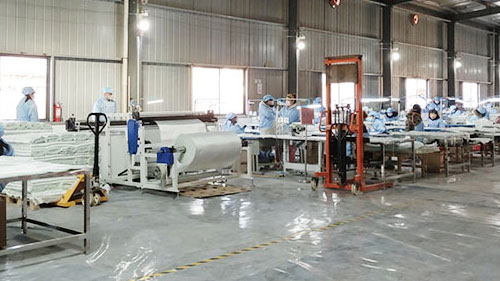Emergency Fire Blanket: Your Essential Guide to Fire Safety
Overview:Discover how emergency fire blankets work, their benefits, and how to use them effectively. Learn to choose the right fire blanket for your home or workplace safety needs.
In a home fire, every second counts. An emergency fire blanket can extinguish small fires in seconds, providing precious escape time for you and your family.
Fire safety is a critical concern for every household and business, and the emergency fire blanket is becoming an increasingly popular choice as a simple yet effective fire suppression tool. Today, we'll comprehensively explore this emergency fire safety device, helping you understand its principles, usage methods, and selection criteria.
What is a Fire Blanket? Understanding the Basic Principles
A fire blanket is a safety device made from fiberglass material or flame-retardant fabric designed to extinguish small initial fires. It works by smothering the fire - cutting off the oxygen supply, which is a crucial element of the fire triangle (fuel, heat, oxygen).
When placed over a fire source, the blanket effectively prevents air circulation, causing flames to die out due to oxygen deprivation. This method is particularly effective for cooking oil fires, clothing fires, or other small solid material fires.
Research shows that fire blankets have a 95% success rate when used during the initial stages of a fire, which is why safety experts recommend every home and workplace keep at least one fire blanket.

Types of Fire Blankets and Their Applications
Fire blankets can be categorized into several main types based on their materials and usage scenarios:
Fiberglass fire blankets: The most common type, offering excellent high-temperature resistance (up to 500°C or higher)
Silicone-coated fire blankets: Feature added silicone coating for enhanced durability and heat insulation
Industrial fire blankets: Larger sizes suitable for industrial environments
Portable fire blankets: Compact and lightweight, ideal for vehicles or outdoor use

Each type has specific application scenarios. For instance, silicone-coated blankets are better for kitchen use as they're easier to clean and maintain, while industrial blankets are suited for high-risk environments like factories and laboratories.
How to Properly Use a Fire Blanket: Step-by-Step Guide
Correct usage is crucial. Follow these detailed steps:
1. Remove the blanket: Pull the black tabs at the bottom of the pouch to quickly remove the blanket
2. Unfold the blanket: Hold the two black heat-resistant handles on either side
3. Cover the fire: Completely cover the fire source, ensuring full oxygen deprivation
4. Wait for cooling: Maintain coverage for at least 30 minutes or until completely cooled
5. Evacuate safely: Even after extinguishing the fire, evacuate and notify fire authorities
Important: Always ensure your escape route is clear when using a fire blanket. If the fire doesn't significantly reduce within 30 seconds, evacuate immediately and call professionals.

Here's how fire blankets compare to other fire suppression equipment:
| Feature | Fire Blanket | Fire Extinguisher | Fire Sand |
|---|---|---|---|
| Ease of Use | Simple | Requires training | Moderate |
| Maintenance Cost | Low | High | Low |
| Suitable Fire Types | Grease, electrical, solids | Multiple types | Grease, liquids |
| Cleanup Required | Simple | Complex | Complex |
| Service Life | Long (3-5 years) | Short (1-2 years) | Long |
Kitchen fires: Especially effective for cooking oil fires, pan fires, or oven fires
Electrical fires: No risk of electrocution when used on electrical equipment fires
Initial stage fires: Early stages of any small solid material fires
Personal protection: Can be wrapped around the body to escape through flames
According to fire department statistics, approximately 85% of kitchen fires can be extinguished in early stages with proper use of fire blankets, preventing greater damage and danger.
How to Choose a High-Quality Fire Blanket
Consider these key factors when selecting a fire blanket:
Certification standards: Ensure products meet ISO9001, CE certification, or local fire safety standards
Size dimensions: Household blankets should be at least 1m×1m; industrial sizes larger
Material quality: High-quality fiberglass should be uniform without strong odor
Temperature resistance: Should withstand at least 500°C
Service life: Most quality blankets last 3-5 years
Professional tip: Check that packaging is intact with clear manufacturing and expiration dates when purchasing. Expired blankets may have degraded materials affecting performance.

Maintenance and Care of Fire Blankets
Regular maintenance ensures readiness in emergencies:
Storage location: Keep in easily accessible areas away from heat and moisture
Regular inspection: Check every six months for intact packaging and damage
Replacement cycle: Replace according to manufacturer recommendations (typically 3-5 years)
Post-use replacement: Replace immediately after use, even if apparently undamaged
Many fire incidents show that poorly maintained safety equipment may fail during emergencies, making regular checks essential.
Frequently Asked Questions
Q: Can fire blankets be reused?
A: No. Even if the blanket appears undamaged, it should be replaced after use as the fiber structure may be compromised.
Q: Which is better: fire blanket or fire extinguisher?
A: Both have advantages. Blankets are better for grease and electrical fires and are simpler to use without training; extinguishers have broader applications but require some skill. We recommend having both.
Q: Do fire blankets expire?
A: Yes. Even unused, blankets deteriorate over time. Typical lifespan is 3-5 years—check the product label for specific expiration dates.
Q: How do I use a fire blanket to protect myself while passing through flames?
A: Fully unfold the blanket, wrap it completely around your body (especially head and torso), and move quickly but calmly through the flames. Remember: only attempt this with small fires and short escape routes.
Product link: 100% fiberglass fire blankets





